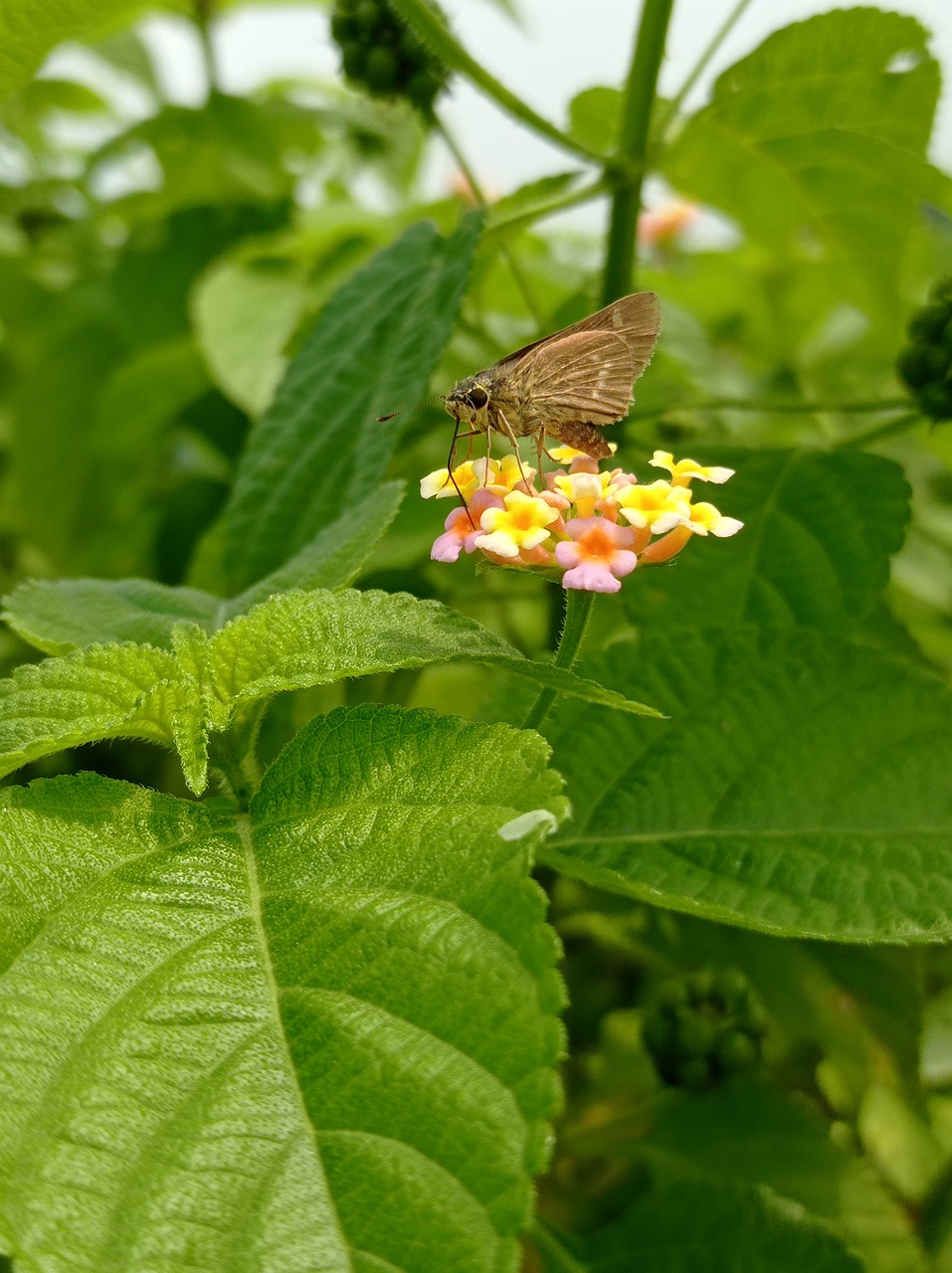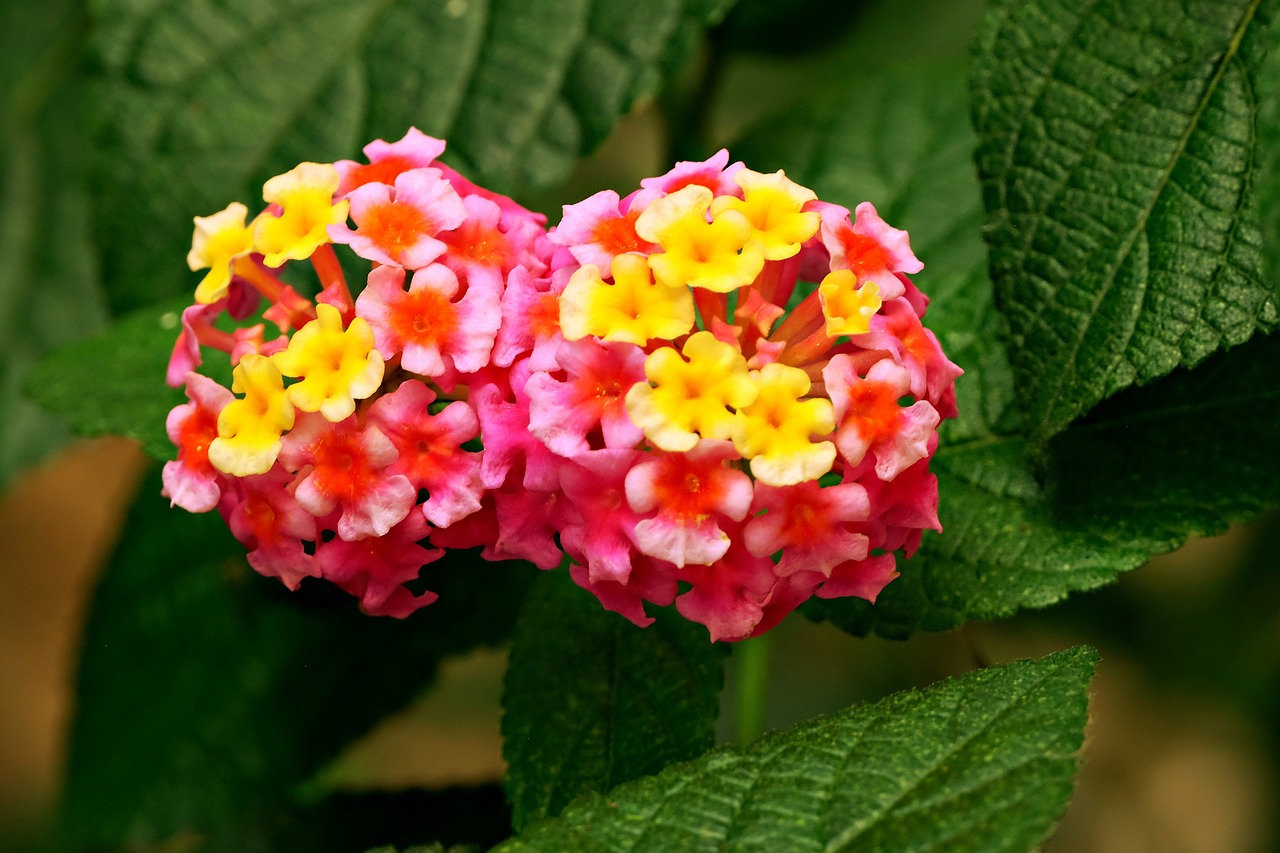In warm climates, lantana is a perennial vining, flowering shrub, but in colder climates, it is an annual. Lantana is a fast-growing plant that produces spherical clusters of small, vividly colored blooms in yellow, orange, white, red, pink, blue, or purple. It is commonly used in hanging baskets and ground covers. Lantana thrives in full sun and needs at least six hours of direct sunlight per day. It prefers neutral, well-drained soil and temperatures above 55 degrees Fahrenheit. Lantana is harmful to dogs, cats, and horses.
| Common Names | Lantana, shrub verbena, West Indian lantana |
| Botanical Name | Lantana camara |
| Family | Verbenaceae |
| Plant Type | Shrub, annual |
| Mature Size | 6 ft. high, 6 ft. wide |
| Sun Exposure | Full |
| Soil Type | Well-drained |
| Soil pH | Neutral |
| Bloom Time | Spring, summer, fall, winter |
| Flower Color | orange, blue, white, pink Red, yellow |
| Hardiness Zones | 7-11 (USDA) |
| Native Areas | Central America, South America |
| Toxicity | Toxic to pets |
Lantana Care
The following are the main care requirements for cultivating lantana:
- Requires full sun.
- Prefers soil that is well-drained and neutral, slightly acidic, or slightly alkaline.
- Needs moist soil and prefers humidity.
- Grows best at temperatures above 55 degrees Fahrenheit.
- Give balanced fertilizer once a year, or once a month if growing in pots.
- Plant as a perennial throughout the year, or as an annual in the spring.

Light
Lantana plants prefer full sun. The plant should get at least six hours (or more) of direct sunlight per day. It can withstand some afternoon shade, but will produce fewer flowers if planted in a shady location.
Soil
These plants prefer well-drained soil. They can grow in most soil types, but require a neutral pH range (6.0-8.0).
Water
Water the lantana thoroughly, about one inch per week, and do not allow it to dry out. With sandy soil, you’ll probably need to water every day. If the blossoming has slowed or stopped completely, try more water.
Temperature and Humidity
Lantana plants grow in USDA zones 7 to 11, where they are evergreen broadleaf varieties. They may tolerate a little frost, but the plant will die if the temperature drops below 28 degrees Fahrenheit or remains cold for an extended period of time. Lantana grows in temperatures of 55 degrees Fahrenheit or higher. It prefers humid conditions and can withstand salt spray.

Fertilizer
Lantana plants require little fertilizer when grown in the ground. Give it once in early spring. They require little upkeep, and using too much fertilizer can reduce the number of blossoms. Feed lantana plants in containers more frequently with a balanced, mild 20-20-20 fertilizer once a month, following the product label directions.
Looking for more gardening tips? Sign up for our free gardening newsletter to receive the greatest growing advice, troubleshooting hacks, and more!
Lantana Tips for Beginners
Where to Put It:
Grow outdoors in an area of your yard that gets full sun (at least six hours per day). Avoid planting near taller plants that will block the sun from your lantana.
How to Water It:
Do not allow lantana plants to dry out; water properly once a week in regular soil or daily in sandy soil.
Soil Type:
This plant only needs well-drained soil, thus the looser and sandier the soil, the better.
Types of Lantana
Most lantana bushes grow up to 6 feet tall in their natural environment; however, if grown as an annual, this fast grower can reach 3 feet tall in a single growing season. The flower’s nectar attracts a variety of butterflies, including the spicebush swallowtail.
- Trailing lantana (Lantana montevidensis) has vining branches that can grow up to 12 inches long and is commonly used in baskets and hanging decorations.
- Popcorn lantana (Lantana trifolia) has petite, colorful flower clusters.
- Wild lantana (Lantana urticoides) is native to Texas and has particularly smelly leaves.
- Lantana pastazensis is native to Ecuador and rarely found outside of its natural habitat it is classified as “vulnerable” to becoming an endangered species.
- Lantana camara ‘Bandito’ has a compact mounding habit and produces orange, red, or pink blooms.
Pruning
If you’re growing lantana as a perennial, pruning is crucial for branching and flowering. Remove the plant’s fruit to control its aggressive growth; after flowering, softly clip the lantana to encourage new flowers on bushier branches. In the spring, cut stems to six to twelve inches from the ground to promote branching and blooming.

If your perennial lantana plant produces berries and you don’t want the seeds to fall and spread, trim it after flowering.
Pruning Tip
Looking for the best pruners to maintain your lantana in top shape? We’ve tested numerous pruners so you don’t have to and selected the top 12 finest ones for you to choose from.
Propagating Lantana
Lantana can be grown or duplicated by starting from seed or stem cuttings. Stem cutting is more dependable because many lantana plants are hybrids that may not reproduce the parent plant when grown from gathered seed. Stem cuttings, on the other hand, will look exactly like their parent.
Take a trimming in the fall when the weather grows colder. Outdoor plants will perish in the winter, but you can grow them indoors in a warm area with grow lights until they’re ready to transplant outside in the spring. Here’s how to proliferate via stem cutting:
- You’ll need pruners, a slice of the plant, a pot of moist seed starting mix or perlite and peat moss mixture, rooting hormone (optional but recommended), a clear plastic bag, and wooden supports (pencils, sticks, or chopsticks).
- Take a 4-inch clip from new growth, eliminating the lower leaves while leaving one or two sets of leaves at the end.
Fill the container with damp potting soil and poke a hole two inches deep with a pencil or your finger. - If you are using rooting hormone, apply it to the stem cutting end and the areas where the leaves were removed.
- Place the cutting in the hole, then fill it with soil, tamping it down and firming around it.
- Place four wooden prop sticks around the perimeter of the potting container.
- Place the clear plastic bag over the cutting, using the wooden supports to ensure that the bag does not touch the stem cutting.
Keep the soil moist, check it daily, and give the plant some fresh air for a few hours each day. - Rooting takes around three to four weeks. When you observe fresh growth or tug on the plant and it feels difficult to pull out of the soil, remove the plastic bag and grow it in a warm, sunny window until it’s ready to go outside.
How To Grow Lantana From Seed
Lantana seeds for planting as annuals in cooler climates are widely available commercially. Harvesting seeds from perennial plants in warmer climates is simple.
When the plant’s black berries ripen, they contain seed pods. Plant seeds indoors six to eight weeks before transplanting them outside.
Take the seeds out of the pods, rinse them with water, and dry them on paper towels for a few days.
Store dried seeds in a sealed jar in the refrigerator until ready to germinate in a tiny pot.
Fill small pots with soilless potting mix, then plant one or two seeds in the center of each pot and cover with medium.
Place the pot of seeds in individual, sealable plastic bags. Keep seed pots wet and in a temperature range of 70-75 degrees Fahrenheit.
Potting and Repotting Lantana
Lantana grows well in containers. Lantana is invasive in warmer, tropical, and subtropical locations, thus it’s better to grow it in a container to control its development. It is safer to grow in the ground in areas where it will die back in the winter, as this prevents invasive spread.
Place the plant in a container somewhat larger than its current rootball. Lantana enjoys small living spaces, so avoid obtaining a large container. Consider adding tiny gravel to the bottom to help with drainage. Use potting soil with good drainage; try adding sand, perlite, or a peat moss mixture.
Repot your lantana when you notice its roots beginning to outgrow the current pot, often indicated by roots emerging from the drainage holes. Be sure to only upgrade to the next size up for the new container. If you want a vining lantana that grows well in hanging pots, L. montevidensis is more vine-like than other types and makes an excellent hanging plant.
Overwintering
Gardeners in colder climates often question if lantana plants may be brought indoors in the fall and overwintered as houseplants. The answer is yes and no. Lantanas can be overwintered indoors, but they do not survive as houseplants unless they are kept warm and under strong, full-spectrum indoor grow lights.
You can also overwinter them in an unheated area that doesn’t drop cooler than 55 F over the winter, keeping them dormant. Provide minimal light and water (approximately 1/2 inch of water per week) until you transplant, or move it outdoors in the spring when temps rise up.
Common Pests
Lantana can tolerate most pests but watch for the following insects that might cause difficulties if the infestation becomes serious. The four most prevalent pests of lantana are aphids, lace bugs, mealybugs, whiteflies, and spider mites. apply insecticidal soap to eradicate pests or apply a solution more specialized to the insect to conserve lantana plants.
Pest: Aphids
Common Cause: New plant growth and nitrogen-rich fertilizers
Signs to Watch For: Sticky “honeydew” residue on plants, leading to sooty mold; presence of ants on plant stems attracted to the honeydew
Pest: Spider Mites
Common Cause: Dry and warm conditions for both air and soil
Signs to Watch For: Fine webbing on leaves; noticeable white speckling on foliage; small, elusive bugs clinging to leaves
Pest: Mealybugs
Common Cause: Soil that is both high in nitrogen and excessively moist
Signs to Watch For: Clusters of small, white, fuzzy masses on stems and leaves
How to Get Lantana to Bloom
Lantanas require full sunlight and regularly moist soil to bloom. Pruning old seed pods or berries can help with bloom difficulties.
Bloom Months
Lantana blooms all year in locations with temperatures over 55 degrees Fahrenheit. Otherwise, it blooms from the spring, when temperatures above 55 degrees Fahrenheit, to the fall, when temperatures fall below 55.
How Long Does Lantana Bloom?
In warm weather, lantanas bloom continually; each flower cluster lasts several weeks before being deadheaded to promote faster, more abundant blooming.
What Do Lantana Flowers Look And Smell Like?
Lantanas are tiny, star-shaped tubular blooms that form flower clusters with bright, fluorescent hues mixed in, resulting in a bicolored effect. The leaves have a sandpapery texture. Lantanas have a strong, not-terribly-pleasant lemony fragrance and are considered aromatic.
How Can I Encourage More Blooms?
To promote fresh blooms, apply a phosphorus-rich fertilizer at half strength and water deeply once a week.
Caring for Lantana After Bloom
When not in bloom, lantana goes dormant, which occurs when the weather cools. If grown outdoors in a subtropical area, limit water to 1/2 inch per week and avoid fertilizer.
Bring the plant indoors if it is consistently below 55 degrees Fahrenheit during the winter; otherwise, treat it as an annual and discard it in late fall or winter when it dies.
Deadheading Lantana Flowers.
Deadhead flowers to inhibit the distribution of berries (and seeds) and promote new blooms.
Common Problems with Lantana
It’s one of the most simple plants to grow as an annual or shrub. It is durable, resistant to salt and drought, and requires little maintenance.
Poor Bloom
If your lantana rarely blooms, make sure it gets full sun, plenty of water, and not too much nitrogen-rich fertilizer. Nitrogen nourishes foliage, which prioritizes leaves above blossoms.
Remove the flower heads of lantanas before they produce berries to stimulate them to bloom. The plant also devotes a lot of energy to producing berries at the expense of blooming. Pruning or pruning back plants promotes fresh growth and more blossoms.
Wilting Foliage
Although these plants become drought-tolerant once established, they still need to be watered at the base during hot weather—at least once a week in the summer.
Leaves Drooping
A lantana’s leaves may droop if it is deficient in nutrients such as iron, potassium, calcium, or phosphorus. To check for deficiencies, use an at-home soil testing kit or submit a soil sample to a lab. Supplement the soil with the nutrients it lacks.
Healthy soil naturally contains the nutrients that plants require for growth; however, nutritional deficiencies occur when the soil loses nutrients owing to soil erosion, runoff, or depletion by other plants. Fertilizer helps to replenish nutrients.








